Thinking of outfitting your off-road rig with solar power? This article looks at 10 of the best off road solar panel choices the industry has to offer – along with an innovative propane-powered generator.
The sound wave that grew from across the salt pan was like a distant, enraged, metallic wasp. A wasp with gears, and gears so long that 5, 6, even 7 seconds separated each upshift. An impossibly high-pitched tone was reached before each new gear was grabbed. In the glare of the vast whiteness of the Bonneville Salt Flats, it’s through sound that you first experience the 200, 300 and, on special occasions, 400mph velocity of vehicles blistering past the spectator area.
The sun’s brutal glare in the basin’s whiteness is blessing and curse alike. Its rays bake the sodium chloride crust (only inches thick) that draws racers from across the globe for Speed Week on the historic Bonneville Salt Flats Race Track. And, if you come properly equipped to take in the blurs crossing the 10-mile race course, that same sun will power your fridge. For free.
In the past decade, powering fridge/freezers and a host of other electric devices (e.g., CPAP machines, drones) has become an expectation of off-road adventurers. Borrowing from the massive RV industry, along with off-shore sailing, today’s off-grid power generation options have seen dramatic gains. Instead of dealing with noisy, heavy gasoline generators, improvements in solar panels have meant savvy consumers can choose from many options.
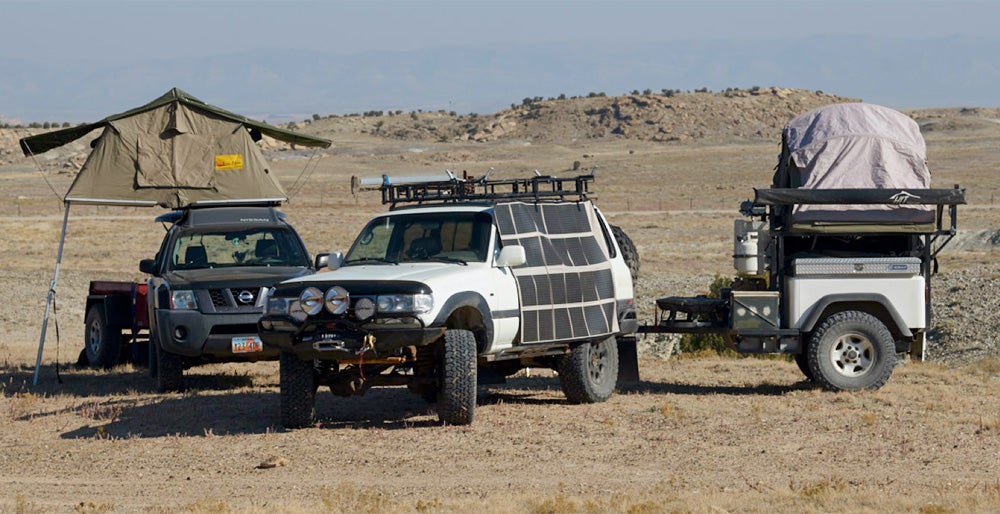
Solar Power Options
That same 12v fridge that keeps your drinks cold and ice cream bars hard in Bonneville’s August heat (temp’s of 90+ in the shade) stands apart as the #1 power draw for a solar system. Today’s large fridges, like the SnoMaster Classic 56, need a properly sized solar system and battery bank to perform without pause.
Solar Power 101: Learning the Basics
Designing a system to power your adventures requires some basic calculations. In previous articles I outlined how to assess those power demands, and then to outline your system.
Choosing a solar panel, the heart of solar systems, is easier than ever thanks to the improved designs offered by leading manufacturers. To demonstrate that variety we contacted 11 brands whose products have gained a strong following in the overland and off-grid adventure travel markets, or which are bringing innovations to the scene. Each manufacturer discussed here offers a somewhat different approach to the market, and the models we reviewed each meet different needs. All of them are appropriate for vehicle-based applications, though some provide flexibility for use away from your rig, or are more easily shared between different vehicle platforms.
Table of contents
- 4thD Solar
- Flexopower: Mojave-240 / Karoo Solar Battery Box
- Goal Zero: Nomad 100 / Yeti 400 Power Station
- Jackery: SolarSaga 60 / Explorer 240 Portable Power Station
- Off Grid Trek
- Overland Solar: Ruck
- P3Solar: P3-75W
- Rhino Adventure Gear: SolarHawk Rooftop Tent Solar Panel
- Solbian: SP72 ALLinONE
- Zamp: 90W Long / 90W Portable
- ALP Propane Generator
- Editor's Verdict
4thD Solar
- Model: GRID- XP160 PORTABLE 160
- Output: 160w / 8.5A
- Solar Panel Dimensions: 28” x 68” (28” x 23” x .8” folded)
- Type: Foldable
Ohio-based 4thD Solar is an engineer-led company that strives for the most robust overland power systems. Built around top-end Merlin panels, their systems allow portable or fixed mounting. The XP160 offers the prior in a tri-fold configuration, complete with fold out soft legs. For building its systems, 4thD uses premium 8 AWG marine grade UV-protected cabling, and employs Anderson SB50 Powerpole connectors. Its charge controllers are no less robust.
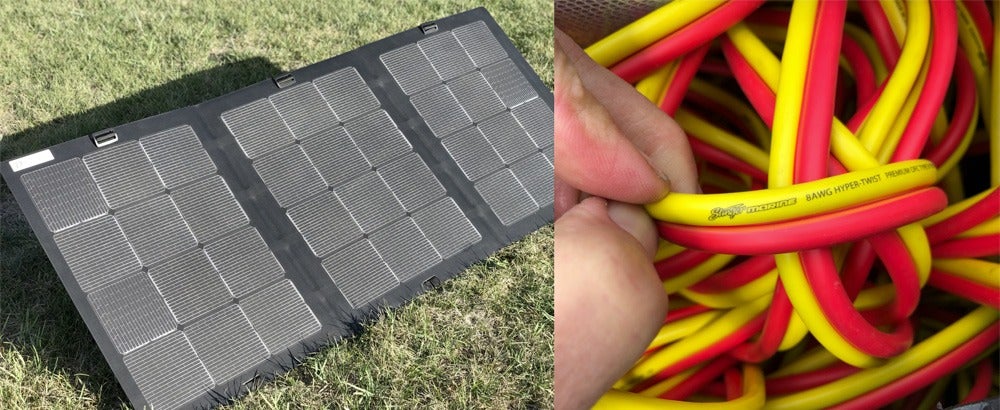
In fact, when you dig into the construction, specs and components the company employs, you notice they are building for durability over the long haul. Using redundancies from failure resistant cell wiring provided in the Merlin cells to other components’ protection from the elements, the company prides itself in offering real-world, candid power output claims. In fact, it may be the only solar brand in this market instigated by an outstanding product—Merlin FX series cells—and a need in the overland arena and resulting in building a company. The resulting systems are aimed towards those building out uncompromising overland platforms.
An interesting aside about 4thD is that its sister company is the N. American importer of Conqueror Off-road Trailers. These remarkably built, transformer-like “caravans” are the most impressive—that is complex and well-built—offered on our continent. 4thD is a logical pairing, therefore, as reliable electrical power is essential for the systems that come standard in Conqueror models. In fact, those same expectations are becoming ubiquitous among those who enjoy vehicle-based exploring. As a result, 4thD is rapidly gaining a committed customer following.
Highlights:
Full spectrum solar solutions, highest quality offerings in all components, emphasizing built-in solar power systems for overland vehicles.
Flexopower: Mojave-240 / Karoo Solar Battery Box
- Output: 240w / 12A
- Solar Panel Dimensions: 33.7” x 21.5” (10” x 12.5” x 0.9” folded)
- Type: Foldable
Out of Africa—South Africa to be specific—comes the leading overland solar brand of Flexopower. Like P3Solar, its tough, portable panels are utilized by national military forces, in this case in the continent’s vast backcountry. Started in 2005, its designs have evolved to avoid the bane of portable solar: micro cracks (that degrade hidden wiring connections) and low light performance.
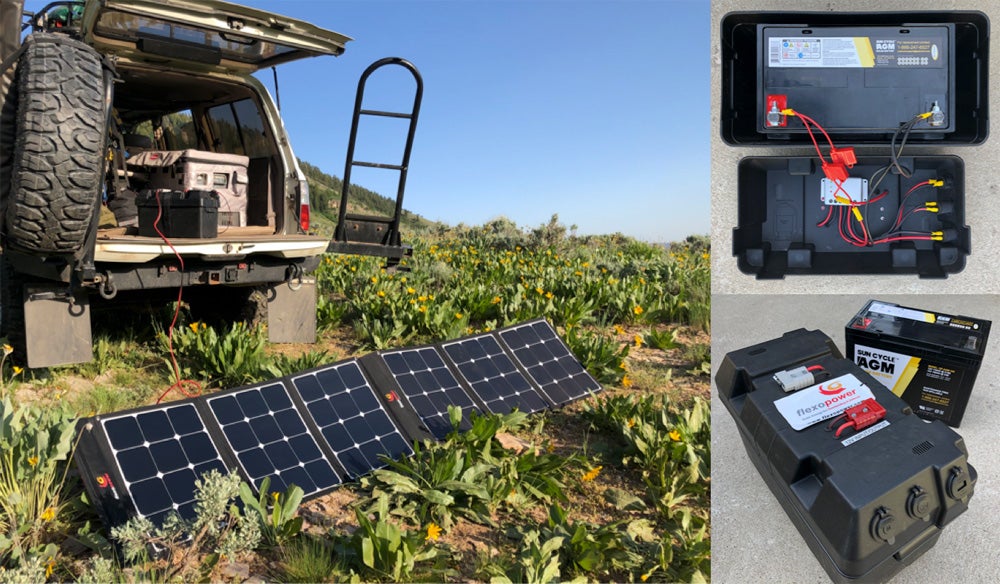
The Mojave system allows daisy-chained panels. Hence the Mojave in the 240w configuration consists of a pair of 120w tri-fold flexible panels. Built for harsh African conditions, a sturdy set of 10m cables is included, allowing for the optimal arrangement: camp-in-shade/panels-in-sun. Tough and simple Anderson SB50 connectors link all system elements, including Flexopower’s solution for deep cycle batteries. Its Karoo Battery Box easily contains a 100Ah battery, has a built-in charge controller, and offers a voltage gauge and accessory power ports.
Regrettably, new U.S. tariffs on foreign solar products have, since 2019, made the N. American market a difficult prospect for Flexopower. As a result, the company is currently taking a more limited stance on serving 4×4 consumers on our continent.
Highlights
Proven in military and civilian use in African, integrated high capacity solar/storage devices, top-tier solar cells.
Goal Zero: Nomad 100 / Yeti 400 Power Station
- Output: 100w / 8A
- Solar Panel Dimensions: 20.25” x 59.5” (20.25” x 15.25” x 1.5” folded)
- Type: Foldable
Goal Zero was born out of a journey to support the people of Africa’s Democratic Republic of Congo. Founder Robert Workman, who I’ve interviewed about the brand’s mission, describes the role of solar power as one of democratizing life essentials such as lighting and access to electricity. The resulting Goal Zero product line makes sense as you consider that focus. From LED lights to a wide selection of battery banks, the company expands solar + battery products to include small portable items like the popular Lighthouse Mini.
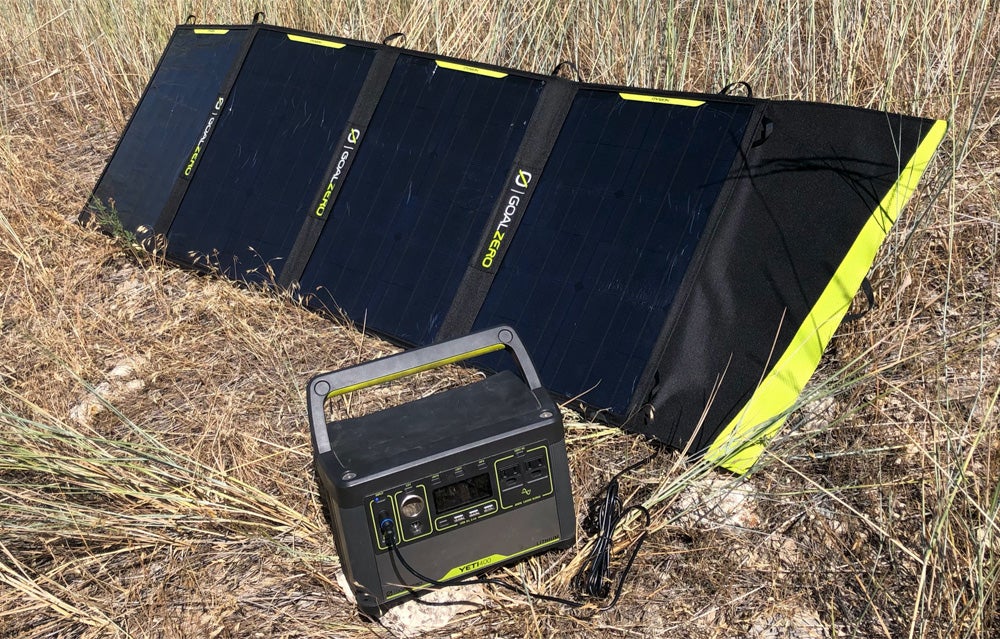
For a full spectrum of portable solar products, it’s hard to beat Goal Zero for diversity and plug-n-play functionality. While coming at a premium price, its products are backed by excellent customer support. For the latest generation Nomad solar panels, its extra attention to features also stand out. From magnetic flap closure to handy accessory storage pockets, this largest folding solar panel from the Utah-based company is easy to use. At least once you have the right cables; its 6mm and 8mm plugs are by no means industry standards, and require (when available) costly cables if you wish to connect to other manufacturers’ components.
For many consumers, the Goal Zero family of products offers an ideal, simplified ecosystem of portable power products, taking the guesswork out of tapping into the sun’s rays. For those liking to mix-n-match, a bit more legwork is required.
Highlights
Extensive product line, tightly integrated systems, strong customer care, commitment to humanitarian aid.
Jackery: SolarSaga 60 / Explorer 240 Portable Power Station
- Output: 60w / 3.3A
- Solar Panel Dimensions: 17.5” x 34” (17.5” x 12” x 2” folded)
- Type: Foldable
Honda. Apple. What do they have in common with solar power? The answer, Jackery Power Outdoors. Co-founded in 2012 by a former battery engineer for Steve Jobs’s Cupertino giant, the brand offers power generation and storage products. Its Power Station line even drew the attention of Honda, which created a co-branding partnership with Jackery.
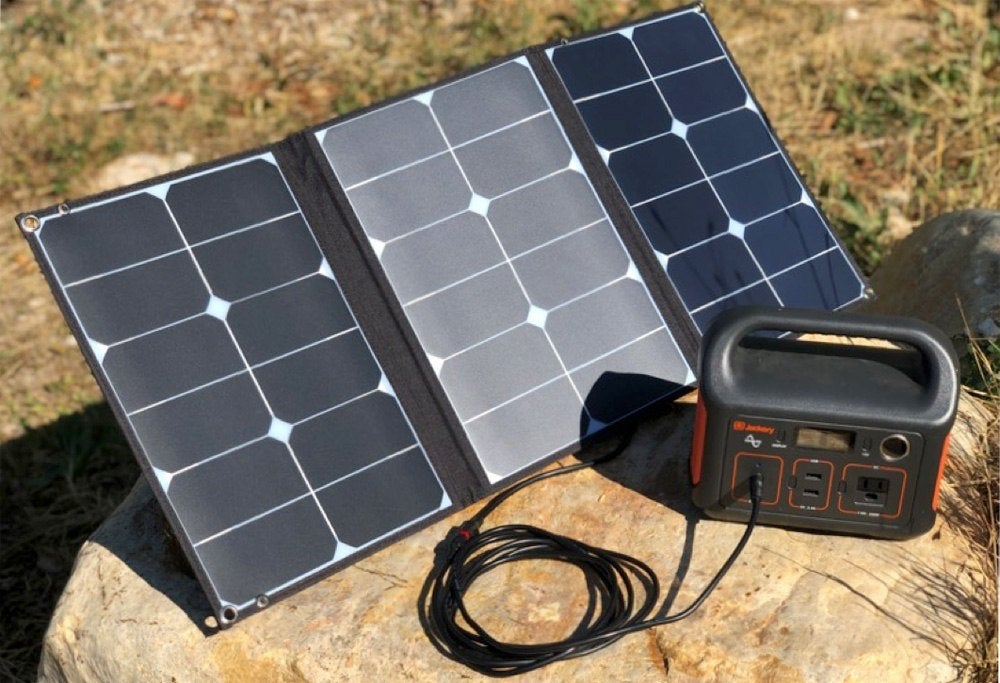
Jackery distinguished itself with the market-leading release of a 2015 Li-ion battery-based device. The Explorer 240, which has been powering our line-up of devices since 2019. It’s light (<7lb), small and pairs perfectly with the SolarSaga 60, Jackery’s mid-sized folding PV panel. With ~17Ah of capacity, the Explorer isn’t going to run your fridge (for long). It will, however, recharge laptops, cameras, drones and so on quite nicely.
Though somewhat limited in its product line, Jackery offers solid performing, paired devices that compete well with other leading brands in the portable power market.
Highlights
Integrated products, affordable Li-ion all-in-one storage, lightweight.
Off Grid Trek
- Model: 215w Solar Blanket
- Output: 215w /11.7A
- Solar Blanket Dimensions: 68.5” x 36.6” (12.6” x 12.6” x 2.8” folder)
- Type: Foldable
When you pick up the pack containing Off Grid Trek’s 215w Solar Blanket it’s immediately apparent this is a system built for base camp, and not backpacking. Tipping the scales at ~14lb (22lb w/ all components), the blanket’s heft comes from ETFE laminar construction housing SunPower Gen 3 Maxeon cells. The folding panel’s rubberized coating adds to its field durability, and the camo pattern allows it to blend into camp surroundings. The thoughtful touches included in its products by no means stop there. Off Grid Trek adds features like 4 USB-IC (InterChip) connections, compatibility with lithium batteries, and numerous connector types to interface with various manufacturers’ devices.
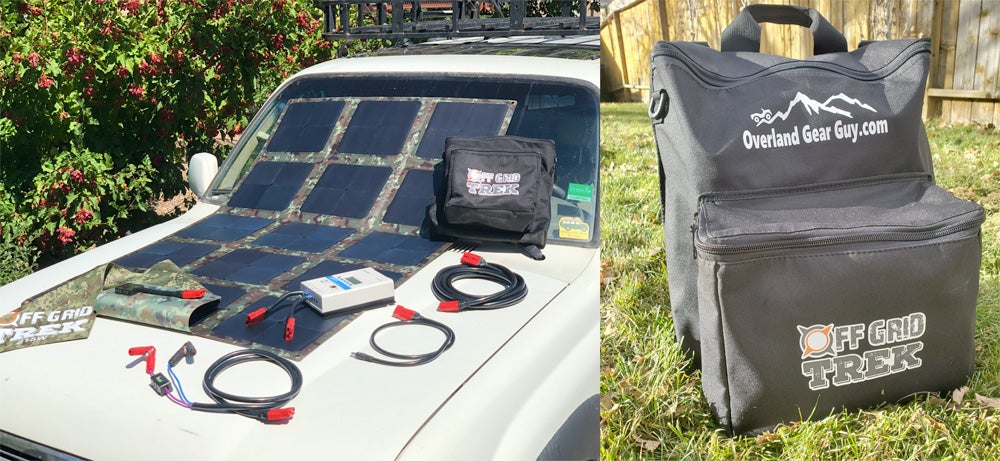
Canadian-based Off Grid Trek also provides an impressive mix of support components not always found among U.S. competitors. Its advantages are particularly evident when shopping for quality power storage. Further, the company offers a Faraday bag to protect sensitive electronic devices from damaging natural or manmade magnetic waves.
Also, what is it with trailers and solar? They seem to go hand-in-glove, as one invariably leads to needing what the other provides. Off Grid Trek is, like 4thD Solar, in both the solar and trailer business. Its imported Echo 4×4 Trailers are the only brand that goes toe-to-toe with Conqueror for its stunning array of features, build quality, and thoughtful layout (including efficient use of space). The brainchild of aviation engineer Willie Grobler, Echo’s trailers give a glimpse of how off-road travel occurs in Africa, Australia and elsewhere. And, of course, the 215w Solar Blanket pairs easily to power the different Echo models and their internal systems.
Highlights
Stout systems ruggedized for austere applications, high output configurations, top-tier cells.
Overland Solar: Ruck
- Output: 60w / 6A
- Solar Panel Dimensions: 58” x 11.5” (6.5” x 11.5” x 2” folded)
- Type: Foldable
Family-owned by overland enthusiasts, Boise-based Overland Solar produces a select line of solutions for explorers and mission-focused field operations. The company’s products have traveled to remote corners of the globe as challenging as the South Pole (e.g., solo ski traverse to its flag-marked axis). Each of the brand’s panels are composed of SunPower’s high efficiency Maxeon Gen 3 cells. For consumers, cell composition is critical, both for the resulting power conversion efficiency (from sunlight to watts), and for the commitment to quality it reveals. Unfortunately, many manufacturers remain silent about the cells they use, instead touting lower prices, while never revealing what corners they cut.
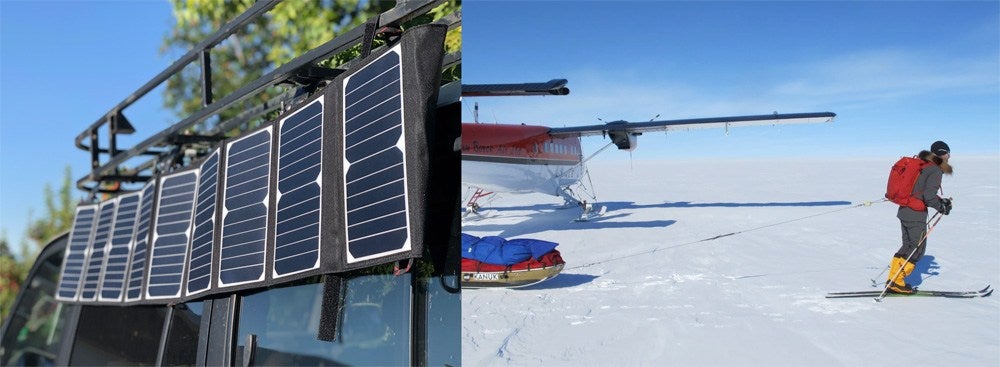
As user power needs have grown, so too have the company’s panel outputs. The newly updated Bugout 130 is their go-to panel for portable applications. Accordioning down to 22” x 7.5” x 3.5”, it weighs just 7lb. Overland Solar, by keeping their manufacturing at their Idaho headquarters, can R&D changes in the surrounding Sawtooth Mountains and Owyhee Desert, enabling rapid product variations. Its SAE or Anderson connector options are just one such example of how the company remains fleet and adaptive.
Overland Solar backs its lineup with an unconditional five-year warranty on manufacturing, coupled with a 20-year guarantee on each panel’s solar cell performance.
Highlights
U.S. made, integrated controller/connectors, compact, top-tier cells.
P3Solar: P3-75W
- Output: 75w / 4.6A
- Solar Panel Dimensions: 61”x24” (10” x 12.5” x 0.9” folded)
- Type: Foldable
Military performance is at the heart of P3Solar’s numerous PV systems. The company, which traces its roots back almost 20 years to Global Solar Energy, early on attracted the U.S. Marine Corps with defense contracts to provide field operatives with power. The overwhelming demands of light weight and toughness thus formed the cornerstone of the brand’s panels.
Having used the P3-75W for several years, the benefits of its thin film cells are clear. Built from CIGs (Copper Indium Gallium DiSelenide) photovoltaic material, the resulting film measures a scant .3” (~.7mm) thick. Offered in 12v or 24v configurations, this and other P3Solar panels are effectively military grade systems offered to the public. Tens of thousands of P3 panels have to date been issued to U.S. and allied troops deployed across the globe.
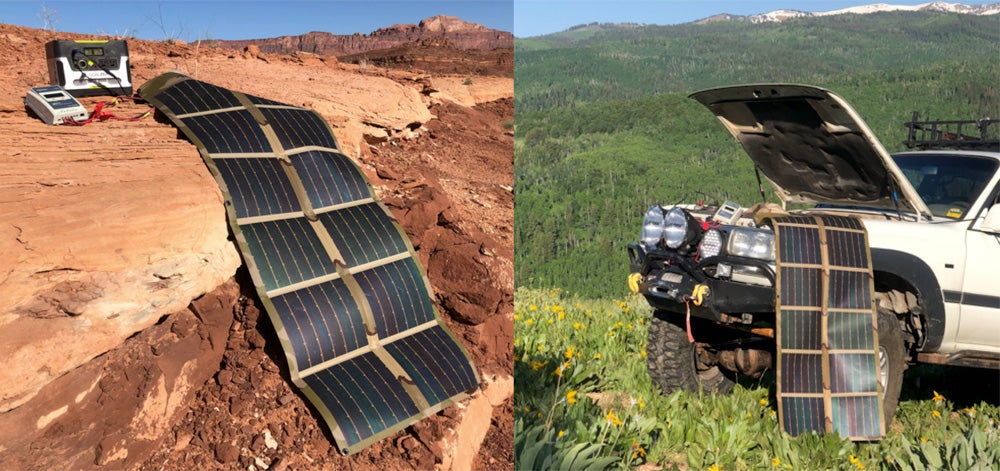
At under a pound, the svelte P3-75W can be taken afield with ease, kept stowed in a vehicle pocket, and deployed quickly. However, its lightweight necessitates all corners be secured if any wind is expected, or when angled layouts are timely to optimize solar gain (i.e., perpendicular to rays). P3Solar offers this and most of its panels in different camo patterns, as well as black and high vis yellow. The company also configures its thin film in rollable panels, as well as base camp systems with collapsible frames.
If there is a downside that comes with these and similar CIGs panels, it’s their conversion efficiency. Rated (perhaps conservatively) at ~14%, P3 panels give up efficiency to gain portability. For comparison, 23% is currently the utmost efficiency rate available, with anything over 20% being excellent.
Highlights
U.S. made, proven military record of applications, lightweight and compact.
Rhino Adventure Gear: SolarHawk Rooftop Tent Solar Panel
- Output: 100w / 4.4A
- Solar Panel Dimensions: 76.7” x 14.8”
- Type: Flexible
So, about those Merlin Solar panels…the San Jose leader in high performance PV cells also drew the attention of nearby California overland outfitter Rhino Adventure Gear. As the key importer of iKamper RTT’s, Rhino saw the logic of mounting a solar panel on the hardshell of a Skycamp. Having personally designed and fabricated a custom armature to stow/deploy a 200w solar array from beneath our own Skycamp, I only wish Rhino’s new SolarHawk panel had come out two years ago! For others, it’s a godsend.
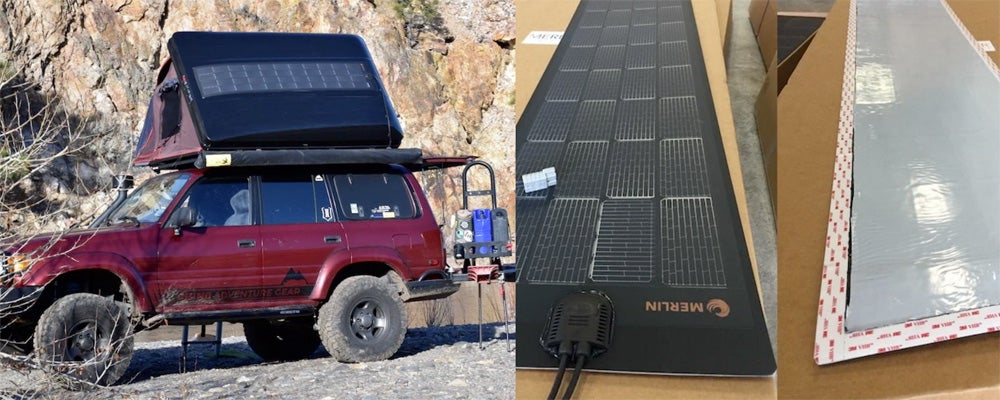
While not a solar power company per se, Rhino Adventure Gear is not alone in seeing opportunities for needed solar products and working with a PV cell manufacturer to spec and sell a new offering. And that’s good for 4×4 adventurers.
Highlights
U.S. made, industrial adhesives make it ready-to-mount on RTT’s, top-tier cells.
Solbian: SP72 ALLinONE
- Output: 72w / 6A
- Solar Panel Dimensions: 33.7” x 21.5”
- Type: Semi-flexible (10% curvature)
If you want a product made for conditions harsher than offroad travel, offshore sailing is a safe bet. Italian brand Solbian has been rated among the very best solar panels for deep water sailers, and their reputation is built around the durability they provide for withstanding constant saltwater conditions, including their use of excellent SunPower cells.
Solbian’s ALLinONE is that rarest of solar panels, in that its charge controller is fully fixed and integrated (no exposed wires) into the panel, and also being fully sealed. That distinct Ferrari-red portion of the panel? That physically and visually smooth element is the entire controller unit. From it extends a generous output cable, the insulation of which is probably the most robust of any we tested here. That’s it. Connect it to a battery and you’re done.

For pure simplicity, clean installation, and build quality, it’s hard to beat the SP72 ALLinONE. Though middle-of-the-pack in wattage output, its right-sized for smaller fridges such as the ARB Classic 50qt or other modest draw camp needs. With its semi-rigid construction, the panel is easy to position for temporary solar capture, such as on a roof rack, against a vehicle tire, or suspended from an RTT awning. Though not equipped with legs, this lack of accoutrement means it stows easily (no bag provided) in a vehicle. Sizes range from 23w to 104w.
Solbian is imported to North American shores via OceanPlant Energy and parent company Bruce Schwab Energy Systems, a leader in powering those who adventure with sail and rudder and sextant.
Highlights
Italian made, integrated charge controller, rated for saltwater environments.
Zamp: 90W Long / 90W Portable
- Output: 90w / 5A
- Solar Panel Dimensions: 58.3” x 13.6“ x 1.5” / 21.6″ x 43“ (21.6″ x 21.5“ x 3.1”)
- Type: Rigid / Rigid foldable suitcase
Discussing vehicle-based solar power in N. America is impossible without inclusion of Zamp. The Bend, OR company has been charging ahead (pun intended) for the past decade, its panels and system components gracing thousands of RV’s. As so-called boondocking has grown in popularity among the Winnebago and 5th wheel crowd, so too has off-grid power. Zamp offers primarily rigid panels for these (generally) rooftop mounting applications. What distinguishes them is, in part, their development of rail mounting systems to securely locate panels, albeit with adjustability built in.

Plug-n-play describes the approach Zamp takes to making solar easy (relatively speaking) and straight-forward. Their customer service, online resources and massive dealer network combine to take much of the guesswork out of building a system. As of 2020, Zamp’s new Obsidian panels go a long way towards cleaning up (visually, in bulk, and aerodynamically) the traditionally boxy aluminum frame that the industry, including Zamp, has used. The new Omni-rail system that pairs with these panels offers a low profile, adjustable foundation for securing and positioning multiple panels. Zamp offers daisy-chaining of such panels, with configurations up to 1000+ watts.
Highlights
Expansive company and dealer network, predominantly U.S. made, excellent customer service, proven record in RV industry.
ALP Propane Generator
What about times when the sun is absent? From winter to canyons to stormy weather, all trips are not blessed with ample sunshine. For those times when solar isn’t reliable, a backup strategy is critical. For 4×4’s, more than one auxiliary battery isn’t likely an option. And while running the vehicle’s engine (and thus alternator) is an option of last resort, it’s better to have another trick up your sleeve.
Enter the ALP Propane Generator. While some solar brands are fond of blurring the lines by using the phrase “solar generator”, for most consumers a generator is a combustion engine-based portable device to create AC and/or DC electricity. But its gasoline that powers those generators, and the results offend both the nose and the ears (and the wallet, in many cases). ALP founder Perry Rubin provided one of the company’s newly released 1000W generators this spring, and it’s clear this isn’t your traditional camp power source.
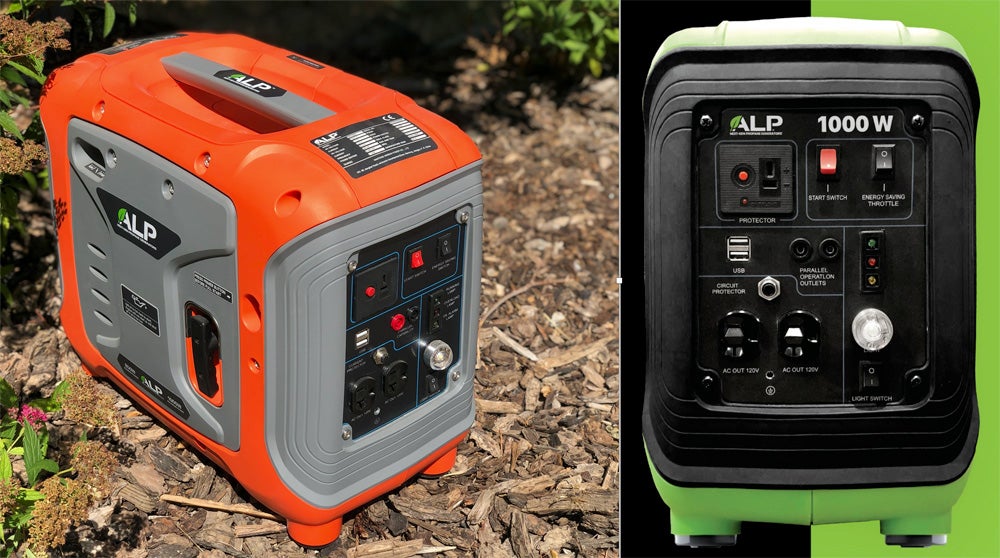
The ALP unit relies instead on that most ubiquitous camp fuel, bottled propane, and weighs only 28lb, while operating at ~50dB when in Eco-mode (aka idle). A new 1lb propane bottle will run the ALP for ~3hr, which is enough to recharge a deep cycle battery, while concurrently powering a 12v fridge-freezer. While no analog for solar, if you need/desire a generator, ALP’s 2020 addition to the market is worth researching.
Highlights
Half the price of a comparable gas generator, compact, intelligent controls, fuel efficient, not obnoxious.
Our Final Verdict
The revolution in backcountry electrical power has arrived, and 4×4 enthusiasts have never had more, or better quality, options. Whether for navigation, food storage, imaging or lighting, electricity provided by solar power systems is now well developed, affordable, and durable. The capacity of PV systems to enhance camping off grid is impressive, and better still they can allow you to stay out (or stay in one place) longer, all without the downsides that gas generators include.
And while Asian made knock-offs are flooding the market, the innovators and U.S.-based brands we’ve tested offer clear advantages. Chances are, if you explore what’s out there, solar will soon be part of your rig’s gear. The military learned solar power’s advantages decades ago, and adventurers today are more gadget-dependent than ever before. Looking down the road (and trail), with the coming revolution in electrical vehicles, it is only a matter of time before solar’s role will also include fueling our 4×4’s. “Siri, pre-order my Rivian”.
Can I run my portable refrigerator off of solar panels?
Technically yes, but you would need more than just solar panels to make it happen. You’d also need batteries to store energy to keep your refrigerator running at night or if you are under cloudy skies and a charge controller to protect your batteries from overcharging. Because of the inconsistent supply of electricity, you can not run your refrigerator directly off of a solar panel.
Do off-road solar panels need to be maintained?
Yes, but the maintenance is minimal. Solar panels just need a light cleaning to remove dust, dirt, leaves or any other debris that might have built up on them and potentially block sunlight. A light wipe down or even a quick rinse with a garden hose can usually do the trick.
For reviews of additional leading solar brands see:
About the Gear Doctor: Dr. Sean Michael has been designing, abusing and testing outdoor gear since the 1980’s, and began reviewing products for Off-road.com in 2000. Today, he is Professor of Outdoor Product Design & Development at Utah State University, a product consultant to leading brands, and a frequent Instructor at Overland Expo. Follow his trips and gear (ab)use @thegeardoctor on Instagram.
We are committed to finding, researching, and recommending the best products. We earn commissions from purchases you make using the retail links in our product reviews. Learn more about how this works.
Updated 05/07/2021: Added faq, updated url links.
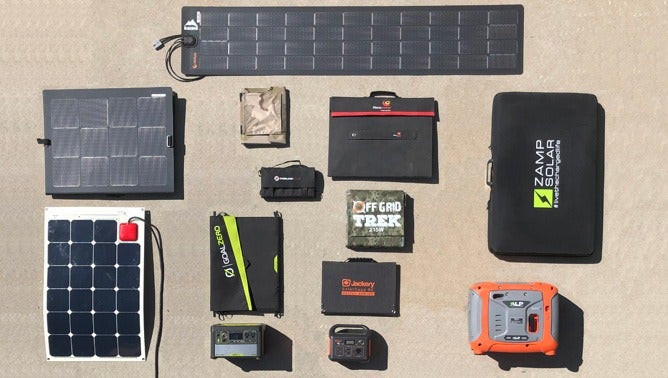
 Your Privacy Choices
Your Privacy Choices